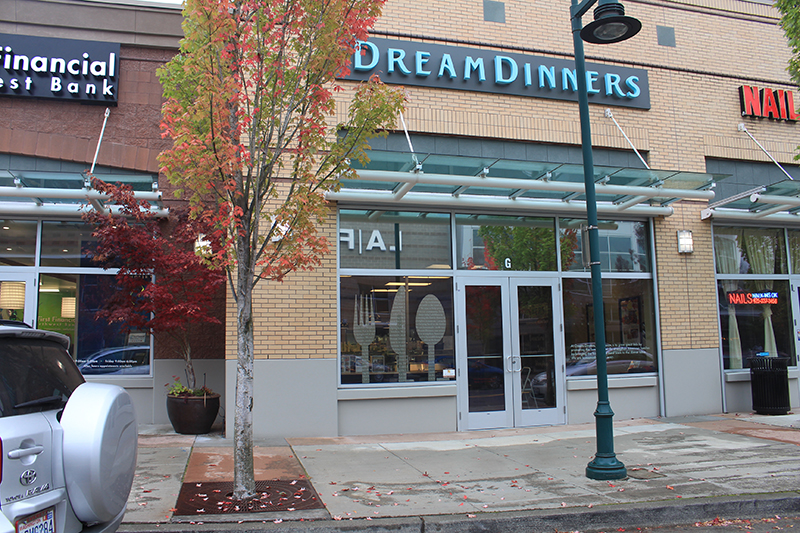By Nancy Weingartner Monroe
Before the meal-kit industry took on America’s kitchens, there were make-and-take meal services whose business plan was to entice young mothers to make a week or month’s worth of meals for the freezer while socializing with their girl friends. Concepts abounded in the mid-2000s, with names like Dream Dinners, Super Suppers, My Girl Friend’s Kitchen and Let’s Dish. Most started franchising right out of the gate, gobbling up the independents.

Darin Leonard, CEO of Dream Dinners
While these were brick-and-mortar sites catering specifically to mothers, how the industry went from multiple franchises totaling 2,500 units countrywide to one franchise is relevant to the Blue Aprons and Hellos Freshes out there. Both business models require customers to make a significant lifestyle shift, said Darin Leonard, CEO of Dream Dinners, the one national franchise that survived. “Not many industries require a style shift,” he pointed out.
While the meal-kit model focuses on young urban professionals, the make-and-take idea was of biblical proportions: gathering women at the well. In this case, women were invited to a party. Bring a bottle of wine, gather up your girl friends and stock your freezer with healthy meals that with minimal assembly are ready to be cooked and served to your family.
By 2008, our sister publication, Franchise Times, was already asking where all the concepts had gone. The 2007 major franchise expos were heavily populated by the concepts, but by the following year exhibitors were noticeably absent. In their heyday, make-and-take storefronts numbered 2,500 nationwide. Today, Let’s Dish has three company-owned units in the Twin Cities, and Dream Dinners, the only franchise still scooping, has 85 units in 25 states, from a high of 230 in 45 states.
To prove how fast an industry can turn, Leonard said after he came to Dream Dinners as a consultant in 2008, the New York Times interviewed him for an article on the make-and-take meal phenomenon. Three weeks later the newspaper killed the story because the industry had taken such a sharp nosedive that a mostly positive article no longer rang true.
Leonard originally was brought in to address churn. About 70 percent of Dream Dinners’ customers came just one time, and the “party” model wasn’t sustainable. So they dug into the data. “We asked 2,800 customers why they didn’t come back,” he said. “What was ironic was nothing was negative. They loved it, and couldn’t believe it had been so long (since their visit).” So clearly the problem was one of “desire versus adoption,” he said.
While parents know that regular family dinners are key to raising “good” children, finding the time to prepare those meals isn’t happening for a lot of families. (The FamilyDinnerProject.com found that children who participate in regular family meals have lower rates of substance abuse, teen pregnancy and depression, and have higher-grade point averages and self-esteem.
Time is one factor, but another one no one seems to be talking about, Leonard says, is the fact that most moms and dads don’t know how to cook. “Moms are living in an impossible world,” he said. All the pictures of perfect-looking food posted on social media by friends and acquaintances “makes her feel like a failure.” And driving through McDonald’s may be guilt producing, but it’s quick, cheap and may offer something her children will eat — or at least a toy they’ll play with for a few minutes.
While the meal kits are targeting urban professionals for the most part, that audience will eventually become parents with picky eaters who won’t be onboard for Blue Apron fare such as Farro & Pickled Rhubarb Salad or Spiced Beef Pitas & Garlic Labneh.
So what did Leonard do to give Dream Dinners a second course? He partnered with a bigger player who could provide a robust supply chain that enabled them to bring down food costs significantly. He also developed a relationship-building component, with friendly, helpful people in the store and email reminders of upcoming bookings. “You need to be in a direct-relationship (with customers),” he said. “You can’t do that through an app or by a contract,” he says. Millennials may not be as hungry for adult conversations as stay-at-home moms, but building loyalty in a crowded field is essential.
Contracts, while necessary, have to be friendly to the user. Shipments that are hard to stop create resentment. While some consumers enjoy the game of canceling one service immediately to take advantage of the special pricing from a competitor, most people don’t have the fortitude to play. Plus it also sabotages customer retention.
No doubt, subscription models work, but meal-kit delivery services need to continually find ways to keep customers engaged, not trapped.
Food safety is another area Leonard thinks could be of concern, since everything is shipped fresh, not frozen. Food waste is also a problem. For instance, according to Bloomberg, Munchery’s San Francisco flagship kitchen, racked up $1.9 million in food waste costs between 2014 and 2016. The typical restaurant throws away between 4 percent and 10 percent of the food they purchase, while Munchery’s was 16 percent, the online news service reported. To use up the food already purchased, Leonard said some meal kits concepts are offering “surprise” or blind boxes to subscribers.
So what’s the takeaway for meal kit entrepreneurs? Keep evolving, but don’t follow the leader in the industry. For instance, in the meal assembly business, franchisees started offering already-prepared meals that customers could pick up instead of dishing up themselves. That proved a bad move, Leonard said because it added another stop in the customers’ already busy life, without a compelling reason.
Make your offer easy to use and one that solves a problem consumers have. Address churn. It’s too expensive to continually attract new customers, you have to retain the ones you have. Keep an eye on food costs, but also on food safety. (Remember Chiptole.) And for goodness sakes, don’t party like it’s 2008.
A Futuristic Return to the Past
Darin Leonard, CEO of Dream Dinners, said he always tries to think ahead of the market. While he’s updating and securing the storefront model for his franchise — they are building their first new store in 10 years — the chain has also launched an online version of sharing a meal, called ShareCrate.
It’s akin to the days when neighbors brought newcomers a welcome to the neighborhood dinner or church members organized a week’s worth of meals for someone who just had a baby or their appendix removed or a loved one die.
The food-gifting category was $18 billion in 2016, up 3.5 percent from 2015, according to Package Facts’ report on the industry. That includes large players like Edible Arrangements, which sends fresh-fruit bouquets as opposed to flowers, as well as corporate gifts on holidays and chocolates on Valentine’s Day.
ShareCrate wants to take on the home-meal market for people who want to give a gift of meals as a one-time occasion and not be roped into having to give a subscription to someone.
Gifters chose from Comfort Classics, Kid Favorites and Heart Healthy, and select medium or large helpings. Meals are shipped to the recipient’s doorstep.
If you have any questions about how it works, go to www.lovingwithfood.com and if you need to moisten your eyes after a day at staring at your computer, check out the video.


